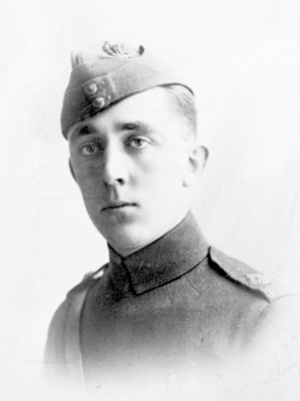Mansell Richard James facts for kids
Quick facts for kids
Mansell Richard James
|
|
|---|---|

Mansell James, with his RFC 'wings' and 'Canada' epaulette bar. Wearing the RFC 'maternity jacket'
|
|
| Born | 18 June 1893 Leamington, Ontario, Canada |
| Died | c. 2 June 1919 (aged 25) Unknown; disappeared in New England |
| Allegiance | United Kingdom |
| Service/ |
British Army Royal Air Force |
| Years of service | 1917–1919 |
| Rank | Captain |
| Unit | No. 45 Squadron RAF |
| Battles/wars | World War I • Italian Front |
| Awards | Distinguished Flying Cross |
Captain Mansell Richard James DFC (born June 18, 1893) was a brave Canadian pilot. He fought in World War I. People called him a "flying ace." This means he shot down many enemy planes. He won 11 aerial victories. Sadly, he disappeared in 1919. This happened after he set a new flying record. Many people searched for him, but he was never found.
Contents
War Service
Becoming a Flying Ace
Mansell James lived in Watford, Ontario, Canada. He joined the Royal Flying Corps in 1917. This was the air force of the British Army. After his training, he became a pilot. He flew a plane called a Sopwith Camel. In February 1918, he went to Italy. He joined No. 45 Squadron.
His first victory was on June 3, 1918. He destroyed an enemy Albatros D.V plane. Just four days later, he destroyed two more. He became a "flying ace" on July 20. This means he had five victories. He destroyed two more Albatros D.V planes that day.
He continued to be very successful. On August 5, 1918, he destroyed a reconnaissance plane. The next day, he shot down three more Albatros D.V planes. By the end of August, he had 11 victories. All his victories were over enemy planes.
Awards and Promotion
On September 23, 1918, Lieutenant James was promoted. He became a temporary captain. In November 1918, he received a special award. It was called the Distinguished Flying Cross. This award recognized his bravery.
The award said he was an "excellent scout pilot." It praised his "great skill, courage and determination." It also mentioned that he had destroyed nine enemy planes.
On May 6, 1919, James left the Royal Air Force. He then traveled to the United States.
Disappearance
The Final Flight
On May 28, 1919, Captain James flew a Sopwith Camel. It was thought to be the first time this plane was flown in the United States. He flew from Atlantic City, New Jersey, to Boston, Massachusetts. He was trying to win a $1,000 prize. This prize was offered by The Boston Globe newspaper. It was for the fastest flight between the two cities.
He flew at 115 miles per hour. This was much faster than other pilots. After landing near Boston, James took off again. He was supposedly heading to Mitchel Field on Long Island. This was on his way back to Atlantic City. People watching his takeoff were surprised by how close he flew.
Captain James planned to follow railroad tracks. He wanted to use them as a guide for his return flight. However, he seemed to follow the wrong tracks. He landed in Tyringham, Massachusetts, to get his plane serviced. This was about 100 miles west of Boston.
On June 2, 1919, he took off from Tyringham. He flew south, then turned west. This was away from Boston. Many local people watched him leave. They were not used to seeing airplanes. Because of his flight direction, they thought he might return. But he never did.
Search Efforts
Many people tried to find Captain James. Searches happened for years after he disappeared. On June 4, 1919, an airplane engine was heard near Millerton, New York. On August 5, 1919, some plane wreckage was found. It was in a ravine on Mount Riga. People thought it might be James's plane.
In December 1925, hunters found more wreckage. It was in the woods near Tyringham. They didn't realize its importance at first. Later, they tried to find it again, but couldn't. James's uncle offered a reward for finding him. This reward was still available years later.
On May 19, 1927, a Coast Guard boat found a plane wing. It was floating in Fort Pond Bay, Long Island Sound. Captain James's brother asked for a description of the wing. He hoped it belonged to his brother's plane. There was also a report that his plane might have crashed in a river. This was near Poughkeepsie, New York. But nothing was found there either.
Despite many searches and rewards, no definite sign of Captain James has ever been found. The plane parts that were discovered were never confirmed to be from his aircraft. His disappearance remains a mystery.
See also
- Flying aces
- No. 45 Squadron RAF
- List of people who disappeared
- List of World War I aces credited with 11–14 victories

